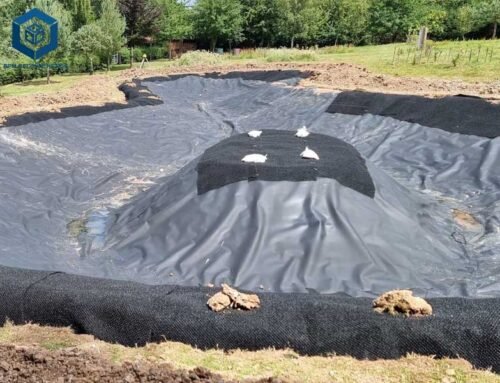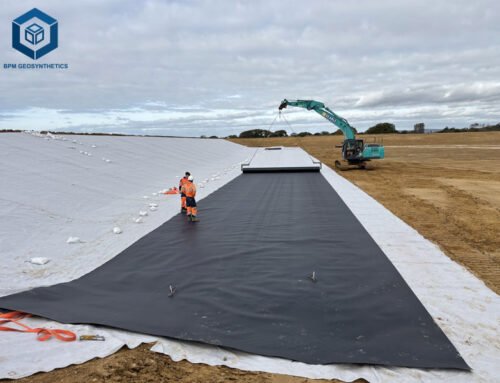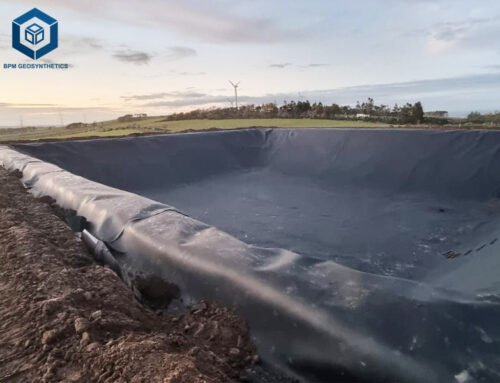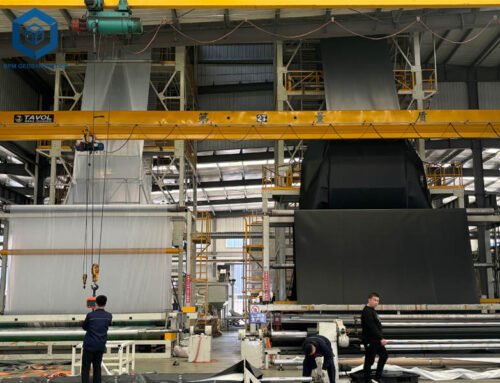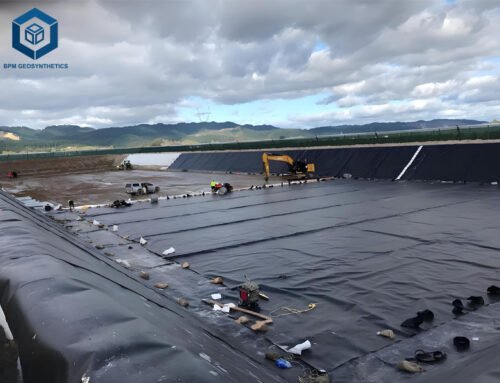Hdpe liner material are synthetic liners widely used in environmental, hydraulic, and industrial applications for containment, barrier protection, and fluid control. Due to their excellent chemical resistance, durability, and cost-effectiveness, Hdpe liner material are a preferred choice for landfills, mining operations, water reservoirs, and agricultural projects.Selecting the right Hdpe liner material requires understanding material properties, manufacturing processes, installation techniques, and application-specific requirements. This comprehensive guide will help you make an informed decision when choosing an BPM geomembrane for your project.
1. What is HDPE Liner Material?
Hdpe liner material is a flexible, impermeable plastic sheet made from high-density polyethylene resin. It is manufactured through an extrusion or calendering process, resulting in a durable, UV-resistant, and chemically stable liner.
1.1 Key Properties of HDPE Liner Material:
- High Chemical Resistance – Resists acids, alkalis, and hydrocarbons.
- Excellent Tensile Strength – Withstands stress and deformation.
- Low Permeability – Prevents fluid leakage.
- UV and Weather Resistance – Long-term performance in outdoor conditions.
- Long Service Life – Typically lasts 20-50 years depending on environmental exposure.
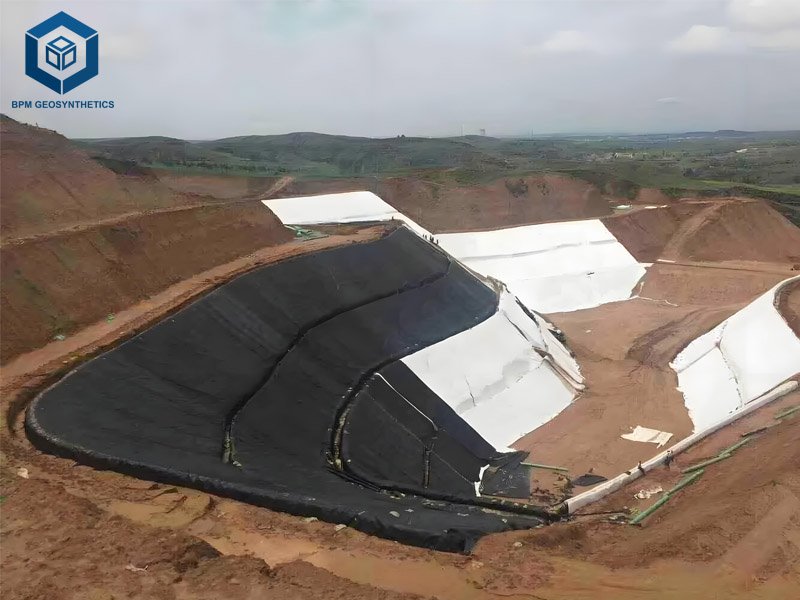
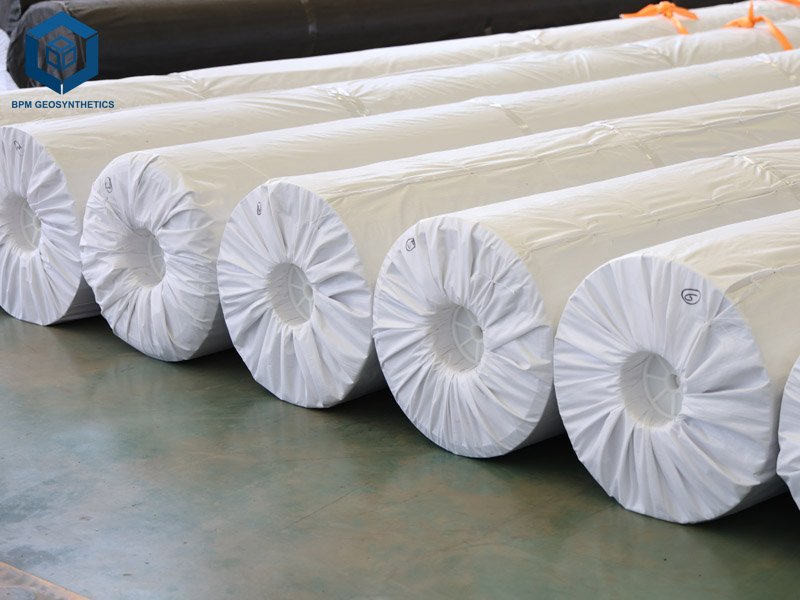
2. Applications of HDPELiner Material
HDPE Liner Material are used in various industries due to their impermeability and durability. Common applications include:
2.1 HDPE Liner Material – Environmental Protection
- Landfill Liners – Geomembranes actively block leachate penetration, creating an impermeable barrier that safeguards soil purity. Additionally, their durable composition prevents chemical migration, effectively protecting groundwater quality. Ultimately, this containment system maintains environmental integrity by isolating contaminants from surrounding ecosystems.
- Wastewater Treatment Ponds – Engineered containment systems actively capture and secure industrial effluents, preventing environmental release. Additionally, municipal wastewater treatment facilities utilize these barriers to effectively manage urban runoff. Ultimately, the systems ensure safe, regulated processing of liquid wastes while protecting surrounding ecosystems.
- Hazardous Waste Containment – Specialized liners actively encapsulate toxic substances, creating impermeable barriers against leaching. Additionally, their multi-layer construction effectively blocks molecular migration into surrounding soils. Ultimately, this containment strategy safeguards ecosystems by preventing hazardous material dispersion.
2.2 HDPE Liner Material – Water Management
- Reservoirs & Canals – Geomembranes actively block water penetration through their impermeable polymer composition. Additionally, their seamless installation eliminates potential leakage points in containment systems. Ultimately, this waterproofing solution maintains consistent water retention in reservoirs and ponds.
- Potable Water Storage – NSF-certified liners actively safeguard drinking water quality with non-toxic, inert materials. Additionally, their seamless construction prevents contamination while maintaining water purity. Ultimately, these potable water membranes deliver reliable, long-term protection for reservoirs and storage tanks.
- Aquaculture Ponds – Aquaculture liners actively prevent water loss by creating impermeable barriers in fish and shrimp ponds. Additionally, their durable construction withstands constant water pressure while resisting punctures from aquatic activity. Ultimately, these containment systems maintain optimal water levels for healthy livestock growth and farm productivity.
2.3 HDPE Liner Material – Mining Industry
- Heap Leach Pads – Chemical-resistant liners actively contain aggressive metal extraction solutions without degrading. Additionally, their reinforced structure withstands high-temperature processing and acidic environments. Ultimately, these containment systems prevent hazardous leaks while enabling efficient mineral recovery operations.
- Tailings Storage – Reinforced geomembranes actively encapsulate toxic mine tailings, creating fail-safe barriers against leakage. Additionally, their multi-layer design resists punctures from sharp waste materials while preventing chemical migration. Ultimately, these containment systems protect surrounding ecosystems from hazardous mining byproducts.
2.4 HDPE Liner Material – Agriculture
- Irrigation Ponds – High-density liners actively minimize water loss by creating impermeable barriers in reservoirs and canals. Additionally, their low-permeability materials reduce seepage rates by over 99% compared to unlined systems. Ultimately, this containment solution significantly conserves water resources in agricultural and industrial applications.
- Manure Storage – Geomembranes actively block nutrient-rich runoff from entering lakes and rivers through secure containment. Additionally, their impermeable design effectively captures fertilizers and organic matter for proper treatment. Ultimately, these barriers prevent algal blooms while protecting aquatic ecosystems from eutrophication.
2.5 HDPE Liner Material – Construction & Civil Engineering
- Tunnel Waterproofing – Vapor barriers actively block moisture penetration through walls and foundations. Additionally, their multi-layer construction effectively resists humidity transfer in both directions. Ultimately, these membranes maintain optimal dryness in buildings and storage facilities.
- Roofing Underlays – Reinforced membranes actively serve as secondary barriers behind primary waterproofing systems. Additionally, they provide reliable backup protection against potential leaks or primary layer failures. Ultimately, this dual-layer approach ensures comprehensive moisture defense for critical structures.
3. Factors to Consider When Choosing HDPE Liner Material
Selecting the right HDPE Liner Material involves evaluating several factors:
3.1 HDPE Liner Material – Thickness (Gauge)
HDPE Liner Material typically range from 0.5 mm (20 mil) to 3.0 mm (120 mil). Thicker membranes offer:
These advanced geomembranes actively achieve superior puncture resistance, crucial for containing sharp waste in landfill operations. Additionally, they demonstrate exceptional stress crack resistance that maintains integrity under constant tension and ground movement. Moreover, their stabilized polymer formulation delivers extended service life even in extreme mining environments. Consequently, engineers increasingly specify them for high-risk containment applications. Ultimately, these enhanced properties provide reliable, long-term performance where standard liners would fail prematurely.
3.2 HDPE Liner Material – Recommendation:
Engineers typically specify 1.5mm to 2.5mm geomembranes for demanding landfill and mining applications where extreme durability is essential. Additionally, agricultural and water containment projects commonly utilize thinner 0.75mm to 1.5mm liners that balance cost with adequate performance. Moreover, the thicker mining-grade membranes actively resist punctures from sharp waste materials and heavy equipment. Consequently, the reduced thickness in agricultural applications provides sufficient protection while optimizing material costs. Ultimately, proper thickness selection ensures both economic and technical project success across different industries.
3.3 Density & Material Quality
Standard HDPE geomembranes actively deliver reliable performance with densities ranging from 0.940-0.950 g/cm³, offering optimal flexibility for most containment applications. Additionally, high-performance HDPE grades with densities exceeding 0.950 g/cm³ provide superior chemical resistance and stress crack protection for demanding environments. Moreover, compliance with GRI-GM13 or ASTM D6392 standards ensures consistent material quality and engineering performance. Consequently, engineers select these certified materials to meet specific project requirements while minimizing risks. Ultimately, proper density selection balances mechanical properties with chemical resistance for long-term containment success.
3.4 UV Resistance & Carbon Black Content
UV-stabilized HDPE actively incorporates 2-3% carbon black to effectively block harmful sunlight degradation. Additionally, standard HDPE without this protective additive rapidly deteriorates when exposed to outdoor UV radiation. Moreover, the carbon black particles uniformly dispersed throughout the material provide long-term solar resistance. Consequently, professionals always specify UV-stabilized HDPE for reliable performance in exposed, outdoor installations.
3.5 HDPE Liner Material – Chemical Resistance
HDPE actively withstands most industrial chemicals but requires verification against specific aggressive substances. Additionally, strong oxidizers like chlorine and hydrogen peroxide may compromise the material’s structural integrity over time. Moreover, aromatic hydrocarbons including benzene and toluene can potentially cause swelling or permeation issues. Consequently, engineers must always review chemical resistance charts and conduct compatibility tests before finalizing material selection.
3.6 HDPE Liner Material – Tensile Strength & Elongation
Quality HDPE geomembranes actively meet minimum tensile strength requirements of 20 MPa (ASTM D6693) to withstand mechanical stresses. Additionally, they achieve at least 700% elongation at break to maintain flexibility during ground movement or installation stretching. Moreover, these robust mechanical properties prove essential for demanding applications like landfill caps subjected to settling forces. Consequently, engineers prioritize these specifications when designing high-stress containment systems requiring both strength and adaptability.
3.7 HDPE Liner Material – Seaming & Installation Method
Extrusion welding actively creates thick, robust seams for critical containment areas requiring maximum strength. Additionally, hot wedge welding efficiently joins long geomembrane sections with consistent, reliable seams for typical applications. Moreover, chemical bonding serves as a specialized solution for field repairs when thermal welding isn’t feasible. Consequently, projects achieve leak-proof installations only when certified technicians perform these specialized seaming techniques.
3.8 HDPE Liner Material – Permeability Coefficient
HDPE geomembranes actively achieve ultra-low permeability rates below 1×10⁻¹³ cm/s, creating near-absolute fluid barriers. Additionally, this exceptional impermeability proves critical when containing hazardous wastes where even minimal leakage poses environmental risks. Consequently, regulatory agencies mandate HDPE for toxic material containment to ensure maximum environmental protection.
3.9 HDPE Liner Material – Temperature Resistance
HDPE liners actively perform across extreme temperatures from -60°C to +80°C while requiring installation slack to accommodate thermal expansion. Additionally, aquaculture applications typically utilize 0.5mm-0.75mm thicknesses, though cost-conscious Southeast Asian markets sometimes opt for 0.3mm liners. Consequently, proper thickness selection balances budget with durability requirements for specific fish farming conditions.
The main advantages of HDPE Liner Material fish pond liner:
* Avoid soil contact and minimize water contamination.
* Prevents waste buildup in the soil and prevents harmful chemicals from leaching into the pond.
* Promotes fish growth while reducing the risk of disease.
* Reduces erosion and facilitates waste removal from the pond.
* Provides a smooth harvesting surface.
* Provides long-term UV protection in tropical facilities.
4. HDPE Liner Material Manufacturing Process
Understanding manufacturing helps in quality assessment:
4.1. Raw Material Selection
Virgin HDPE resin actively delivers superior durability and consistent performance in demanding containment applications. Additionally, recycled HDPE offers cost savings but compromises long-term reliability and material properties. Consequently, engineers typically specify virgin resin for critical projects where maximum lifespan is essential.
4.2. Production Methods
Extrusion actively produces both smooth and textured HDPE sheets with precise thickness control for standard applications. Additionally, calendering enables manufacturing of thicker liners exceeding 2.0mm for heavy-duty containment needs. Consequently, manufacturers select these processes based on project-specific performance requirements and installation conditions.
4.3. Quality Control Tests
Quality control tests actively verify HDPE geomembrane consistency through standardized Melt Flow Index (MFI) measurements. Additionally, density testing precisely confirms material grades meet specified performance requirements. Moreover, ASTM D4833 puncture resistance evaluations rigorously assess the liner’s durability for field conditions.
5. HDPE Liner Material vs. Other Geomembrane Materials
| Feature | HDPE | LDPE | PVC | EPDM |
| Chemical Resistance | Excellent | Good | Moderate | Good |
| UV Resistance | Excellent | Good | Poor | Excellent |
| Flexibility | Moderate | High | High | Very High |
| Lifespan | 20-50 years | 15-30 years | 10-20 years | 20-30 years |
| Cost | Low-Medium | Medium | Medium | High |
Best Choice:
- HDPE for landfills, mining, and harsh chemical environments.
- LLDPE for flexible, conformable liners (e.g., ponds).
- PVC for short-term projects requiring high flexibility.
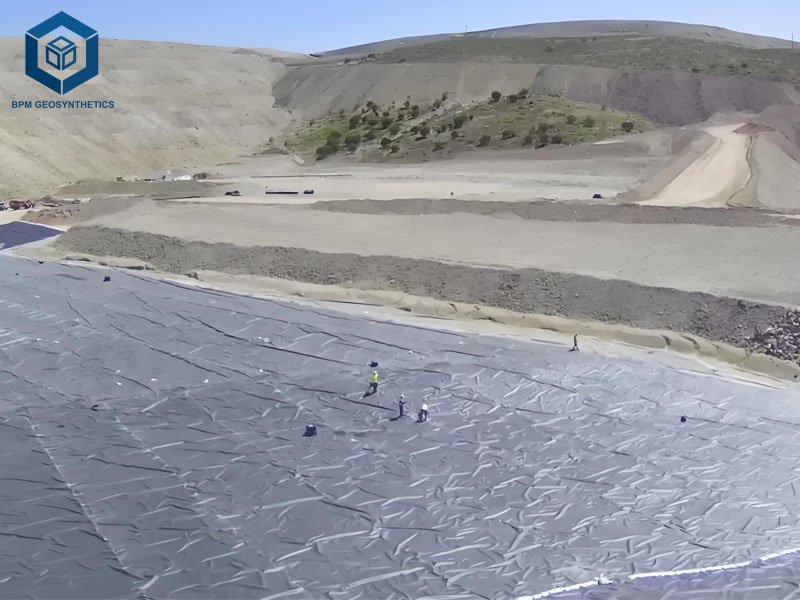
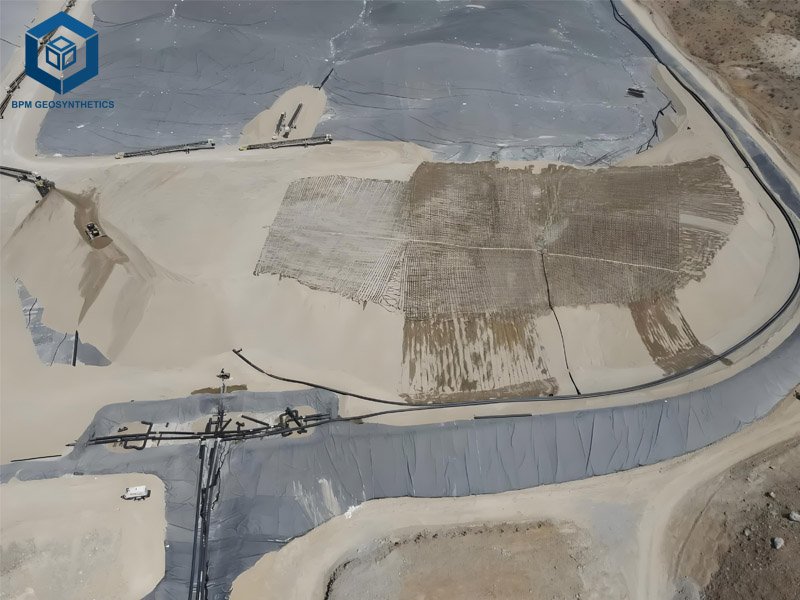
6 HDPE Liner Material – Common Mistakes to Avoid
- Choosing the Wrong Thickness – Leads to premature failure.
- Poor Seaming – Causes leaks (always hire certified welders).
- Ignoring UV Protection – Reduces lifespan in exposed applications.
- Inadequate Subgrade Prep – Increases puncture risk.
7. Summary
HDPE Liner Material is an ideal and cost-effective geosynthetic material for fish ponds. Choosing the right HDPE Liner Material thickness depends on several factors, including the size of the pond, soil type, the intended use of the pond, the possibility of sharp objects, and environmental factors, which all affect the choice of HDPE liner thickness.
High-density polyethylene pond liner is the HDPE Liner Material of choice for most applications due to its unique properties such as chemical resistance, puncture resistance, flexibility, etc. If you have a fish pond project under construction or planned to be built, and you don’t know how to choose the material, thickness, etc. of the pond liner, you can contact us. Our engineers are online 24 hours a day to serve you. BPM Geomembrane is a leading HDPE pond liner manufacturer and supplier with more than 20 years of industry experience. If you have any questions about HDPE liner specifications, please contact us. BPM Geosynthetics can provide you with free sample support!

